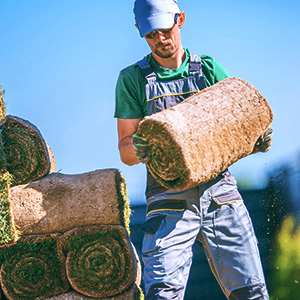We offer Hard & Soft Lawning Solutions
This all changed with the invention of the lawnmower by Edwin Beard Budding in 1830. Budding had the idea for a lawnmower after seeing a machine in a local cloth mill which used a cutting cylinder (or bladed reel) mounted on a bench to trim the irregular nap from the surface of woollen cloth and give a smooth finish
What you get with Beautiful lawning
the 1850s, Thomas Green of Leeds introduced a revolutionary mower design called the Silens Messor (meaning silent cutter), which used a chain to transmit power from the rear roller to the cutting cylinder. The machine was much lighter and quieter than the gear driven machines that preceded them
Extremely responsive & Retina ready
This went hand-in-hand with a booming consumer market for lawns from the 1860s onward. With the increasing popularity of sports in the mid-Victorian period, the lawn mower was used to craft modern-style sporting ovals, playing fields, pitches and grass courts for the nascent sports of football, lawn bowls, lawn tennis and others
We Ensure the Success of Your Green and Garden
The rise of Suburbanisation in the interwar period was heavily influenced by the garden city movement of Ebenezer Howard and the creation of the first garden suburbs at the turn of the 20th century. The garden suburb, developed through the efforts of social reformer Henrietta Barnett and her husband, exemplified the incorporation of the well manicured lawn into suburban life. Suburbs dramatically increased in size. Harrow Weald went from just 1,500 to over 10,000 while Pinner jumped from 3,00 to over 20,000. During the 1930s, over 4 million new suburban houses were built and the ‘suburban revolution’ had made England the most heavily suburbanized country in the world by a considerable margin
Facility provided
A lawn is an area of soil-covered land planted with grasses and other durable plants such as clover which are maintained at a short height with a lawnmower.
Dedicated 24/7 Support Our Support Service is always available 24 hours a day, 7 days a week to help you create your own business solution.
Lawns began to proliferate in America from the 1870s onwards. As more plants were introduced from Europe, lawns became smaller as they were filled with flower beds, perennials, sculptures, and water features.Eventually the wealthy began to move away from the cities into new suburban communities. In 1856, an architectural book was published to accompany the development of the new suburbia that placed importance on the availability of a grassy space for children to play on and a space to grow fruits and vegetables that further imbued the lawn with cultural importance.Lawns began making more appearances in development plans
European colonization, the grasses on the East Coast of North America were mostly broom straw, wild rye, and marsh grass. As Europeans moved into the region, it was noted by colonists in New England, more than others, that the grasses of the New World were inferior to those of England and that their livestock seemed to receive less nutrition from it. In fact, once livestock brought overseas from Europe spread throughout the colonies, much of the native grasses of New England.


Kentucky bluegrass (Poa pratensis) is a grass native to Europe or the Middle East. It was likely carried to Midwestern United States in the early 1600s by French missionaries and spread via the waterways to the region around Kentucky. However, it may also have spread across the Appalachian mountains after an introduction on the east coast. Kentucky Bluegrass is now one of the top three pasture grasses in the United States and the most desirable species.
Farmers at first continued to harvest meadows and marshes composed of indigenous grasses until they became overgrazed. These areas quickly fell to erosion and were overrun with less favorable plant life. Soon, farmers began to purposefully plant new species of grass in these areas, hoping to improve the quality and quantity of hay to provide for their livestock as native species had a lower nutritive value. While Middle Eastern and Europeans species of grass did extremely well on the East Coast of North America, it was a number of grasses from the Mediterranean that dominated the Western seaboard.









